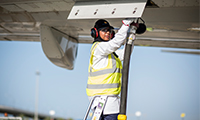Preparing for emergencies
We make sure that we have the necessary resources to deal with spills, leaks, fires and explosions, both offshore and onshore. We regularly test our oil-spill and emergency response procedures and capability to ensure employees and contractors can respond rapidly to an incident.
In 2018, we trained around 850 employees on four large-scale oil spill exercises – two in the USA, one in Kazakhstan and one in the Philippines. All the exercises involved our emergency response contractors and joint venture partners, and local authorities. The events included training followed by two-day exercises to test and practice our organisational capability to manage a worst-case spill incident.
For example, in our Kazakhstan joint venture North Caspian Operating Company (NCOC) (Shell interest 16.81%), an exercise designed and led by Shell simulated a leak from a damaged oil pipeline near reed beds in shallow water, making it difficult to respond by boat. The simulation tested the necessary procedures required to effectively use dispersants and control in-situ burning. The exercise involved close collaboration with our joint venture partners and local government officials.
All our offshore facilities have plans in place to respond to spills. We have resources available on location, for example, floating barriers to contain an oil spill, or through our contractors, such as collection vessels and aircraft used for spill monitoring or dispersant spraying when permitted. We were founding members of the Subsea Well Response Project consortium (now part of the Oil Spill Response Limited), an industry group which aims to improve well-containment globally, and the Marine Well Containment Company, a non-profit industry body providing a response system for the Gulf of Mexico.
During drilling operations, we gather and analyse information about wells to better understand the geology of the area. Pressure and temperature sensors track conditions in real time so that we can immediately detect any changes. Shell-operated drilling activities are continually monitored from onshore operating centres which allow oversight and timely technical support.
 Our people
Our people
 Sustainable development goals
Sustainable development goals
 About our data
About our data
 Electricity
Electricity